
It’s easy to fall in love with Lisbon’s charm. Photo courtesy of Contiki.
BAIRRO ALTO
Bairro Alto or the Upper District is a neighbourhood in central Lisbon. It formed as a result of urban expansion in the 16th century and serves as the perfect nightlife hub for your time in Lisbon (we recommend taking the Contiki 15-day Spain, Morocco and Portugal Independent Insider adventures trip) to spend loads of time in the city. It’s a popular area with bars and restaurants that is the beating heart of Lisbonite nightlife. It’s filled with locals and visitors from all over the world and is also representative of the diverse identity boasted in Lisbon. It’s great for socializing and meeting new people. With drinks taken on the street and the small bars all close together, it creates a communal gathering point of the youth of the city! As a traveller it provides variety and accessibility as well as an affordability to begin or end your evening here. There’s live music in some of the bars and something for everyone!
Park Rooftop Bar
A must-see bar located on the top level of a five story parking lot with a trendy modern setting, great music and a great view of Lisbon. It’s very quirky and cool to go share drinks with people! It caters to people looking for a unique setting as well as one of the best chill out places to enjoy a drink as the sun sets; or get the evening started with local DJ’s setting the sountrack while you find your groove. This is definitely something more known to the locals and it’s a great way to maximize otherwise unused spaces in the heart of Lisbon. Tv. André Valente, 1200-109
Museode la Farmacia de Santa Catarina (The Pharmacy Museum of St Catherine)
Opened in June 1996, the Pharmacy Museum is a project that over the years has been a reference on national and international level. The museum is the result of a clear will of the Portuguese pharmacies in preserving the history of their profession. It also doubles as one of the trendiest cocktail bars with an outdoor setting. Pick a cocktail named after any medicine and enjoy the great view over Lisbon from up top the hill where this hidden gem is located. R. Mal. Saldanha 1, 1249-069
Palacio Chiado
Ever wandered what it would have been like to dine in a palace built in the 18th century? The Quintela Palace has been reborn in the hands of three partners who realized that it was a unique business opportunity, where they could develop an original concept never before attempted in the capital. The first priority was to restore the paintwork and stained glass, maintaining the original characteristics, remaining true to the palace’s historical past. As such, you now have one of the best places to dine in Lisbon with food that will make you want to stay in Portugal forever! It’s such a great place to go to treat yourself and be wowed by the perfect blend of old and modern. R. do Alecrim 70, 1200-018
Jardin do Sao Pedro da Alcantara (Garden of Saint Peter of Alcantara) + Lisbon Tram
If you find yourself getting caught up in the wonders of the Bairro Alto atmosphere and want a little breath of fresh air, take a short work to one of the most famous lookouts over central Lisbon located in the garden of Saint Peter of Alcantara. A quiet nook perched perfectly to grant you the opportunity to take a seat and gaze over the wonderful city-scape. It’s an ideal spot to relax as well as catch glimpses of locals enjoying the great weather Lisbon is so famous for. It’s also located next to one of Lisbon’s oldest forms of transport: The Tram. The famous white and yellow trams of Lisbon have been in service since 1873 and today still provide access to many parts of the city. The famous Tram 23 is a highlight to take as it takes you on the best route to see the city. Loved by locals and tourists alike, take a step back in time and enjoy a very particular piece of history! R. da Atalaia 105, 1200-037
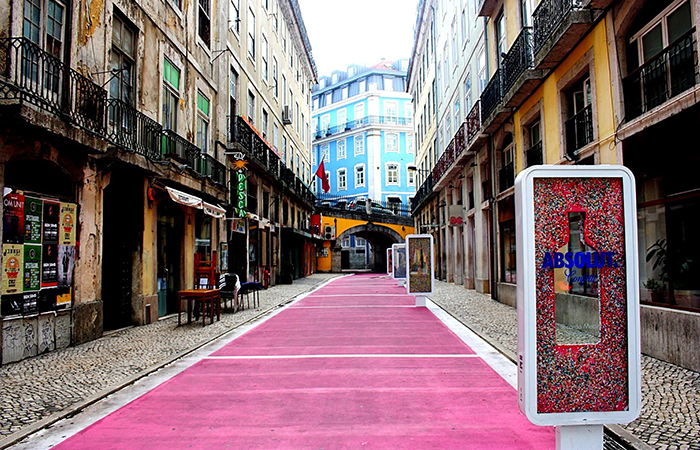
You can’t miss the Rua Nova do Carvalho. Photo courtesy of Contiki.
Rua Nova do Carvalho (AKA. Pink Street!)
This is a wonderful street painted pink that hosts a variety of great bars, restaurants and clubs. Located at the bottom of Bairo Alto it has a little bit of everything to begin or spend the night. There’s a high concentration of trendy modern bars that has ushered in a new wave of nightlife that to the city. This is a great place for locals to gather and experience the new age in innovation in social bars, cafés and restaurants. R. Nova do Carvalho 40, 1200-161
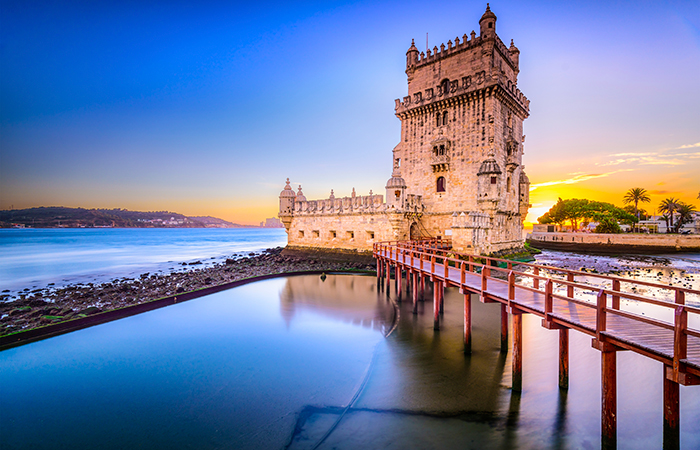
The Tower of Belém. Photo courtesy of Contiki.
BELEM
Belém, deriving from the Portuguese word for Bethlehem, is the historic centre point for Portuguese achievements and history. Tying in with the history and legacy of Lisbon as a city, it boasts the main sights and cultural highlights of the city. It’s great for pictures, history, museums and the best pastry in the world – the famous Portuguese custard tart, the Pasteis de Belém!
Torre de Belém (Belém Tower)
The most recognizable landmark in Lisbon, the Torre de Belém represents a hallmark to the Age of Discoveries. Built in 1515, this UNESCO World Heritage Site has since stood as a vigil at the mouth of the river Tagus watching all who enter Lisbon by sea. It survived the 1755 Lisbon Earthquake and is beautifully constructed in the Manueline style and incorporates many stonework motifs of the Discoveries era as well as work depicting “Our Lady of Safe Homecoming”, who was believed to protect sailors at sea. If you only had one monument to see in Lisbon, this would be it. There are many turrets, balconies, cloisters and cannons for you to clamber over and take Insta shots before you head down into the vaulted dungeon to check out where political prisoners were held. The ceiling is so low it’s impossible to stand up. The riverside promenade means you can walk along to the other main sights if you wish and at any time of the day is a glorious thing to do. You haven’t been to Lisbon unless you go back home with a photo of yourself alongside this monument. Av. Brasília, 1400-038
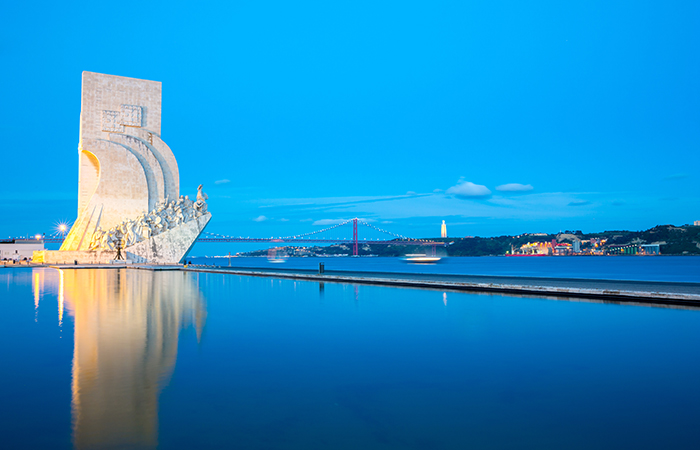
A piece of history at the Monument to the Discoveries in Belém. Photo courtesy of Contiki.
Monumento dos Descobrimentos (Discoveries Monument)
Conceived in 1939 for the 1940 Portuguese World Fair as a temporary installation, this monument now lives on as an idealization of Portuguese seafaring exploration of the globe started by one of its most beloved sons, Henry the Navigator. It represents a three-sailed ship ready to depart, with sculptures of important historical figures who all pioneered the Portuguese Golden Age. The pavement in front is decorated with a mosaic that was offered by the South African government in 1960 depicting a compass with the map of the world charting the routes taken by the Portuguese explorers. Once you’ve snapped every angle of this beautiful piece you can venture inside to view its temporary exhibitions or take the elevator to the top to catch a breathtaking birds eye view of Lisbon from the river’s edge. Av. Brasília, 1400-038
Mosterio do Jeronimos (Monastery of the Hieronymites)
This is one of the most incredible pieces of architecture in all of Portugal. The Monastery of the Hieronymite Order stands today as the perfect representation of the Gothic Manueline architectural style Portugal has become famous for. In 1496 King Manuel petitioned for permission to build a monastery at the site. It was a popular place for sailors to spend the night before their journey, praying for good fortune and safe passage. It also houses the burial of two of Portugal’s most significant sons: the explorer Vasco de Gama (who discovered the first route around the Cape of Good Hope to India) and the Portuguese equivalent of Homer, Luis de Camoes, who wrote ‘Os Luisiades’ a grand epic poem revered in Portuguese literature. Surviving the 1755 Lisbon Earthquake, it still remains today as a symbol of the area of Belem and Lisbon. It’s free to enter to see the wonders inside. However, you’ll need to pay to enter the fabled cloister but it’s well worth the price of admission to peer inside the old walls and wonder at the beauty! Praça do Império 1400-206 Lisboa, 1400-206
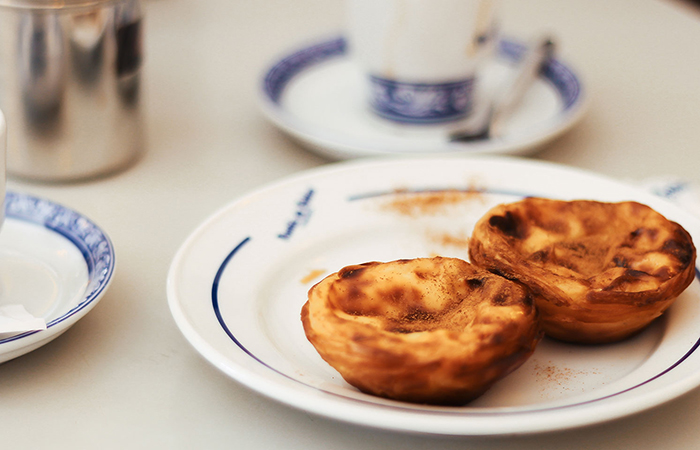
Just try and not eat ones of these famous tarts. Photo courtesy of Contiki.
Pasteís de Belém
Exploring a city is tiring business and it tends to make one hungry. What better way to satisfy that craving than by talking a short walk from the monastery to Pasteís de Belém, home to the world famous Pasteís de Belém or commonly known as the Portuguese custard tart? Produced since 1837, the patisserie has managed to hold on to the secret recipe of Portugal’s most beloved pastry for almost 200 years, and is still housed in the original location. The tart has become so popular that it has reached the far reaches of the world where it’s served in Macau and in Hong Kong, it’s called dan tat (or egg tart in Cantonese)! Served fresh and hand made every day, you will never not find a line snaking its way out of the shop as the delicious waft of goodness draws all to its doors. It’s to be eaten in the traditional way, with a helping of white icing sugar and cinnamon which you can add on top yourself. The crunch of the perfect pastry and the warm custard culminate in a sensation that will leave you wanting more. For those travelling on any Contiki trips that visit Lisbon, who will always make a stop here as part of their extensive list of ‘No Regrets Inclusions’, beware! Always buy two, because trust me, one is never enough! R. de Belém 84-92, 1300-085
Aos Combatentes do Ultramar (Monument to the Portuguese Soldiers Overseas)
Located at the Bom Sucesso Fort, this monument commemorates the soldiers that fell in the Portuguese Colonial War which was fought between Portugal and the emerging nationalist movements in its African colonies between 1961 and 1974. Fought as a single conflict in three different areas – Angola, Portuguese Guinea and Mozambique – it is a reminder to those who gave their lives with the majority having had their homes in Lisbon. A wonderful testament to Portugal’s ability to face its past, the monument stands today as two slanted pillars over arching an eternal flame, a reminder to the lives lost in war with the names of every individual who lost their lives etched onto the encompassing walls that surround the monument. The national royal guard stand guard and it is an extremely important living reminder for a history that is at times steeped in blood and atrocity. The old fort also houses a military museum and sits on the edge of the river Tagus and is still today a proud reminder of Portugal’s empire of old. Forte do Bom Sucesso, 1400-038
ALFAMA
Alfama is the oldest district of Lisbon spread on the slope between Sao Jorge Castle and the Tagus River. Breathtaking views and a medieval maze, it’s like a village within a city and one of the most rewarding for walkers and photographers. Walking through its old-fashioned neighbourhood is now like stepping back in time. Whitewashed houses with tile panels, wrought-iron balconies adorned with pots of flowers, drying laundry strung up across streets and household birds chirping merrily along. Alfama has inspired many writers and even though Bairro Alto is the city’s traditional Fado quarter, it is Alfama that has been the inspiration behind the type of music that brought it UNESCO status. As local as it gets, this neighbourhood is filled with many delights and sounds for visitors of all types.
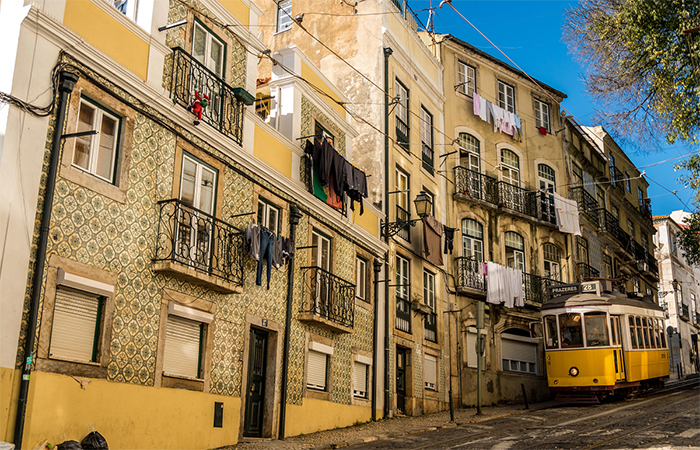
The famous tram in Alfama. Photo courtesy of Contiki.
Castel de San Jorge (‘The castle of Saint George’)
Who doesn’t want to have their own castle? You can experience what that might be like if you decide to visit this wonderful historical heirloom perched high on one of Lisbon’s many hills. It will give you the best views over the city from its ramparts and the true beauty of Lisbon’s colour comes to life as the sun brings the pastel colours and their terracotta roofs to their fullest expression. There’s a reason why Lisbon’s colour is so famous. The Tagus frames the spectacle and the view alone is worth the walk up! Saint George’s castle can be seen from almost everywhere in the city and its oldest parts date from the 6th century. It was then dedicated to St. George, the patron saint of England to commemorate the Anglo-Portuguese pact dating from 1371 and became the royal palace until another one was built. Most of the castle was destroyed over the years, particularly during the 1755 earthquake, but it still includes many of the original walls and 18 towers. R. de Santa Cruz do Castelo, 1100-129
Panteão Nacional (National Pantheon)
Originally built as a church in the 17th century, it was converted into the National where important Portuguese personalities are buried. It is located in the Alfama neighborhood, close to another important Lisbon monument, the Monastery of São Vicente de Fora. It’s worth taking a visit to the final resting place of some of Portugal’s most influential figures. It not only houses historical figures, but also contemporary people who have found a resting place in this beautiful sanctuary. Eusebio, the legendary football (soccer) player, as well as Amalia Rodrigues the famous Fado singer lie here. It is boasts a beautiful white domed neo-classical building tucked away in solitude among the neighbourhood of Alfama. Campo de Santa Clara, 1100-471
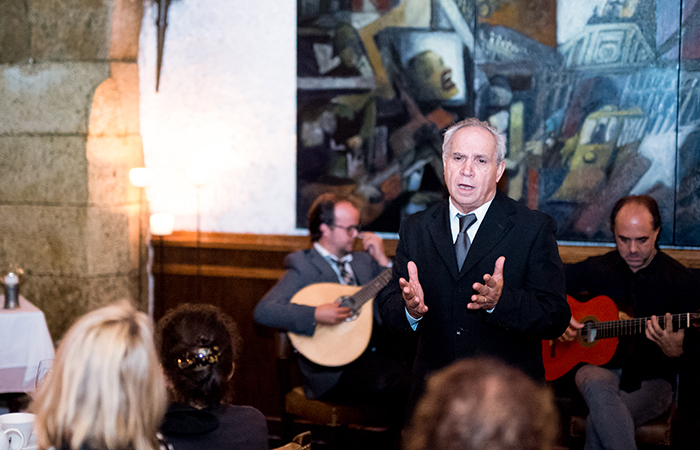
Be sure to catch a Fado show in Alfama. Photo courtesy of Contiki.
Fado
Fado is a music genre that can be traced back to the 1820’s in Lisbon but it probably has much earlier origins. Although the origins are difficult to trace, today fado is commonly regarded as simply a form of song which can be about anything, but must follow a certain traditional structure. In popular belief, fado is a form of music characterized by mournful tunes and lyrics, often about the sea or the life of the poor, and infused with a sentiment of resignation, fatefulness and melancholia. This is loosely captured by the Portuguese word saudade, or “longing”, symbolizing a feeling of loss (a permanent, irreparable loss and its consequent lifelong damage). Alfama is the inspiration for this wonderful art form as it is a music of the people, from the people and I would highly recommend going to see a show during your free days on the Madrid to Lisbon adventure. My favourite place to experience this would have to be the intimate setting of Parreirinha de Alfama which gives you a dining experience and show that will transport you back in time to lull in the melancholic notes of the Fado singer! Beco do Espírito Santo 1, 1100-222
Igreja de São Vicente de For a (Chruch of Saint Vincent)
The original Monastery of São Vicente de Fora was founded around 1147 by the first Portuguese King, Afonso Henriques. The Monastery, built in Romanesque style outside the city walls, was one of the most important monastic foundations in mediaeval Portugal. It is dedicated to Saint Vincent of Saragossa, patron saint of Lisbon, whose relics were brought from the Algarve to Lisbon in the 12th century. The present buildings are the result of a reconstruction ordered by King Philip II of Spain, who had become King of Portugal (as Philip I) after a succession crisis in 1580. The church of the monastery was built between 1582 and 1629, while other monastery buildings were finished only in the 18th century. It is a wonderful look into the type of grandeur that religion inspired in Portugal and the founding of its dedication to the Holy. Largo de São Vicente, 1100-572
The Feast of St. Anthony (Sardine Festival)
Many Catholic countries around the world have must-do religious festivals that you should attend. Although many are now associated with non-religious activities, there are some festivals that are quite simply intriguing. One of them is the Lisbon Sardine Festival, or the Feast of St. Anthony. Every year, from June 12-14th, Lisbon honours St. Anthony of Padua with a festival and holiday. Preparation for the festival takes weeks. All the narrow streets and plazas in some of Lisbon’s oldest neighbourhoods mesmerize locals and visitors with their colourful decorations. During the celebration, Lisbon also prepares for a mass wedding celebration at the Igresia de Santo Antonio. A lively parade with dancers in traditional costumes, massive parties on many street corners, and a plethora of makeshift grill stations and bars that sell Portuguese sardines, beer, and sangria. It lasts the whole night until sunrise. It will be one of the most unforgettable things you do and the delicious smell of the sardines on the grill wafting through the streets with the enjoyment of life and the warm hospitality of the Portuguese will make it a memory you’ll never forget.
More From Travel & Style:
An Insider’s Guide to Porto’s Coolest Neighbourhoods
Frequent Flyer Jillian Harris’s Packing Essentials
5 Tips for First Time Cruisers
The Top 5 Spas in Scottsdale, Arizona

